The Lewis Structure approach provides an extremely simple method for determining the electronic structure of many molecules. It is a bit simplistic, however, and does have trouble predicting structures for a few molecules. Nevertheless, it gives a reasonable structure for many molecules and its simplicity to use makes it a very useful tool for chemists.
A more general, but slightly more complicated approach is the Molecular Orbital Theory. This theory builds on the electron wave functions of Quantum Mechanics to describe chemical bonding. To understand MO Theory let's first review constructive and destructive interference of standing waves starting with the full constructive and destructive interference that occurs when standing waves overlap completely.
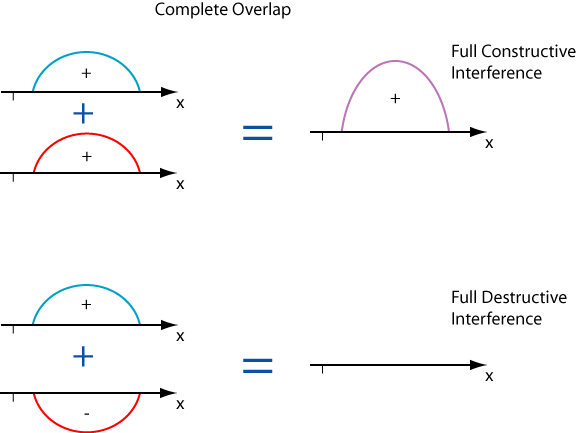
When standing waves only partially overlap we get partial constructive and destructive interference.
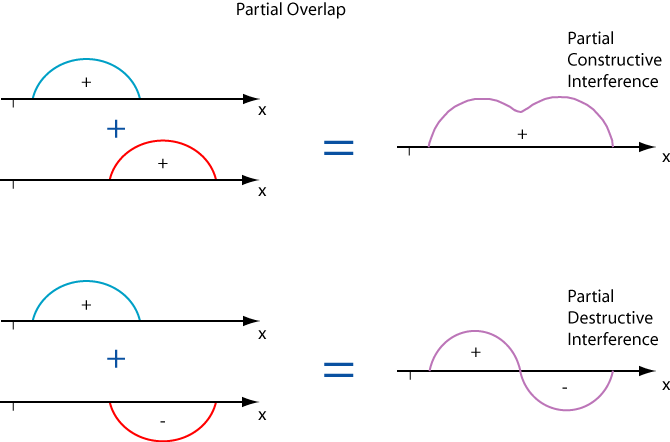
To see how we use these concepts in Molecular Orbital Theory, let's start with H2, the simplest of all molecules. The 1s orbitals of the H-atom are standing waves of the electron wavefunction. In Molecular Orbital Theory we view the bonding of the two H-atoms as partial constructive interference between standing wavefunctions of the 1s orbitals.

We can also have partial destructive interference.

The energy of the H2 molecule with the two electrons in the bonding orbital is lower by 435 kJ/mole than the combined energy of the two seperate H-atoms. On the other hand, the energy of the H2 molecule with two electrons in the antibonding orbital is higher than two separate H-atoms. To show the relative energies we use diagrams like this:
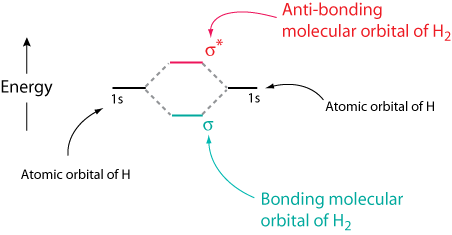
In the H2 molecule, the bonding and anti-bonding orbitals are called sigma orbitals (σ).
- Sigma Orbital: A bonding molecular orbital with cylindrical symmetry about an internuclear axis.

When atomic orbitals are combined to give molecular orbitals, the number of molecular orbitals formed equals the number of atomic orbitals used. So the two 1s orbitals of H combine to give the σ orbitals of the H2 molecule. A molecular orbital (like an atomic orbital) can contain no more than two electrons (Pauli Exclusion Principle), and are filled starting with the lowest energy orbital first. In general, the energy difference between a bonding and anti-bonding orbital pair becomes larger as the overlap of the atomic orbitals increase. Now let's look at some examples:
The H2+ molecule has only one valence electron.
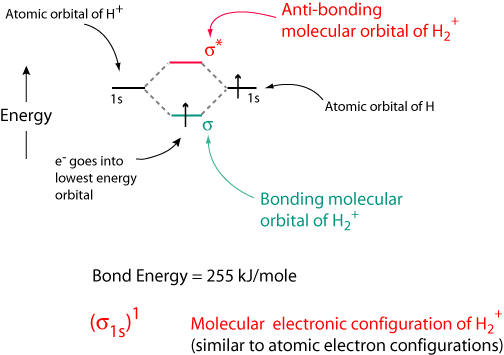
The H2 molecule has two valence electrons.
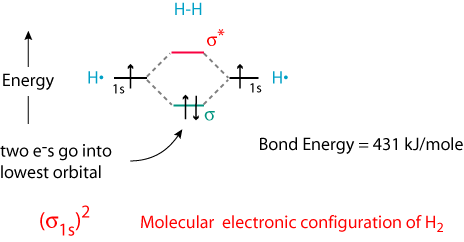
The He2+ molecule has three valence electrons.
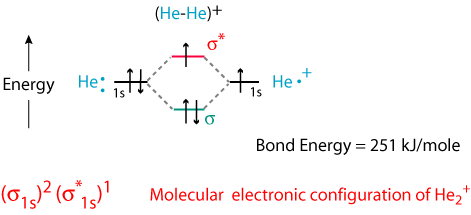
The He2 molecule has four valence electrons.
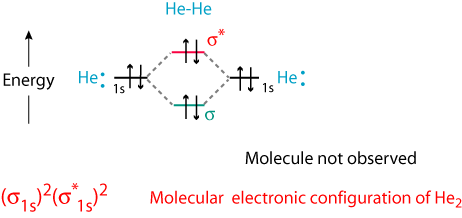
In the Lewis Structure Theory we had single, double, and triple bonds, in the Molecular Orbital Theory we similarly define the bond order.
Bond order = 1/2 (# of electrons in bonding orbitals - # of electrons in anti-bonding orbitals).
The bond order in our four examples above are given in the table below.
| Bond | Bond Order |
|---|---|
| H2+ | 1/2 |
| H2 | 1 |
| He2+ | 1/2 |
| He2 | 0 |
The bond order must be positive non-zero for a bond to be stable. He2 has a bond order of zero and that is why the He2 molecule is not observed.
We can also form bonding orbitals using other atomic orbitals. To a first approximation only orbitals with similar energies can combine. For example, we can combine two p orbitals to form a sigma bond:

Using p orbitals a second type of orbital called a π orbital can also be formed.
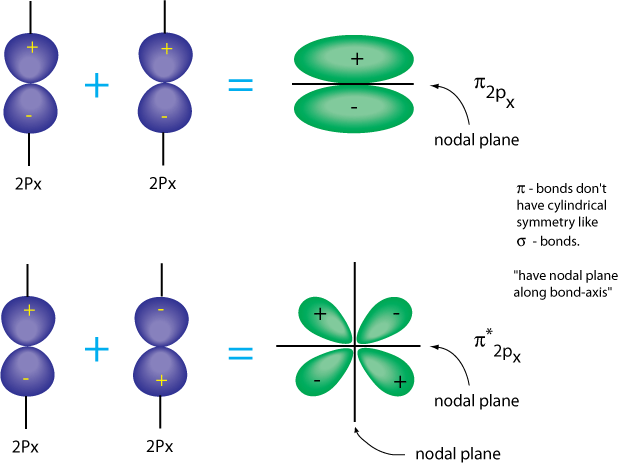
Let's look at some examples where we have bonds forming between the s and p orbitals of two atoms bonding together.
For example, e.g. O2 has 6 + 6 = 12 valence electrons which can be placed in bonding and anti-bonding orbitals.
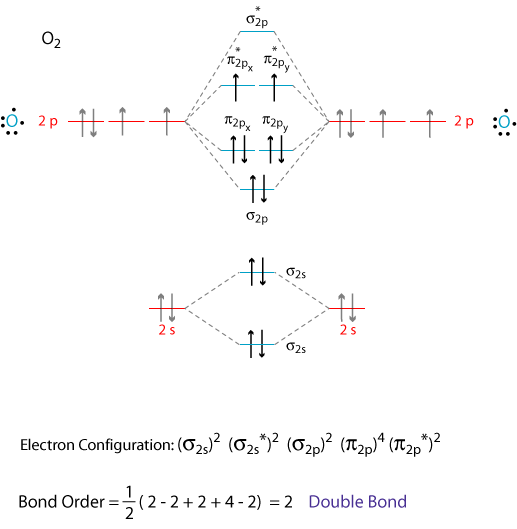
Notice that Molecular Orbital Theory predicts that O2 has unpaired electrons, so it will be paramagnetic.
- Show that iron metal is paramagnetic - is attracted to a magnet.
- Show chalk is not paramagnetic - is not attracted to a magnet.
- Show that liquid nitrogen is not paramagnetic - passes through pole faces of a magnet - shown on overhead projector.
- Show that liquid oxygen is paramagnetic - sticks to pole faces of a magnet - shown on overhead projector.
Another example is F2. It has 14 electrons which are placed in the bonding and anti-bonding orbitals starting with the lowest energy orbital first.

In the case of B2, C2, and N2 there is a slightly different ordering in orbital energies.
For example, B2 has 3 + 3 = 6 valence electrons.
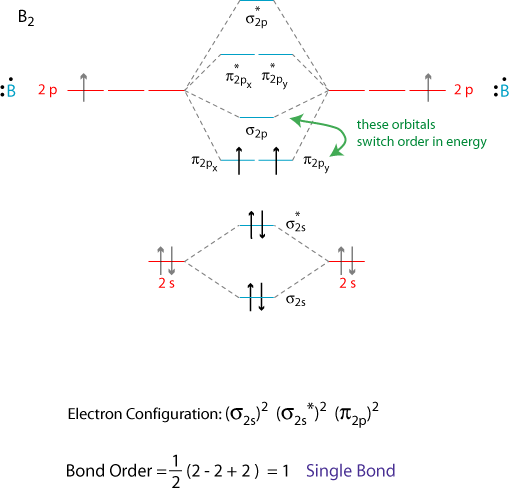
For much nicer three-dimensional renderings of all the bonding orbitals visit Mark Winter's Orbitron site .
Homework from Chemisty, The Central Science, 10th Ed.
9.49, 9.53, 9.57, 9.59, 9.61, 9.63, 9.65, 9.67, 9.69, 9.71

